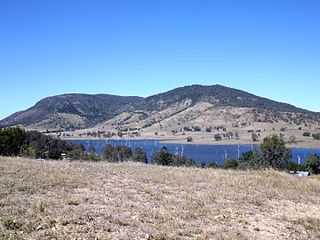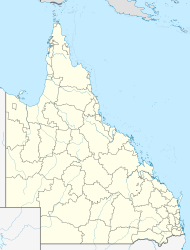Alton is a national park in the Balonne Shire local government area of South West Queensland, Australia.
Auburn River National Park is a protected area in the North Burnett Region, Queensland, Australia. It is in the north-east of the locality of Hawkwood extending into southern Dykehead.

Bribie Island National Park is an Australian national park in the City of Moreton Bay, Queensland, 68 kilometres north of Brisbane. The park covers approximately one third of Bribie Island. The tidal wetlands and areas of water around the islands are protected within the Moreton Bay Marine Park.

Burrum Coast is a national park in the Bundaberg Region, Queensland, Australia.
Chesterton Range is a national park in South West Queensland, Australia, 585 km west of Brisbane. It is located north east of Morven in both the locality of Redford in the Maranoa Region and Tyrconnel in the Shire of Murweh. It lies in the water catchment areas of three waterways. These are the Warrego River, Wallam Creek and the Maranoa River. The park protects part of the Brigalow Belt South bioregion. To the north and the west of the park is Orkadilla State Forest. The average elevation of the terrain is 544 metres.
Erringibba is a national park at Glenmorgan in the far west of the Darling Downs region of southern Queensland, Australia, 329 km west of Brisbane. The park was established in 1999 and covers 8.77 km2 (3.39 sq mi). The park lies within the catchment area of the Condamine River and the Brigalow Belt South bioregion.

Eubenangee Swamp is a national park in Eubenangee in the Cairns Region, Queensland, Australia, 1332 km northwest of Brisbane. It is part of the Coastal Wet Tropics Important Bird Area, identified as such by BirdLife International because of its importance for the conservation of lowland tropical rainforest birds. It plays home to over 190 species of birds.
Eurimbula National Park is a protected area in the locality of Eurimbula, Queensland, Australia, in the Gladstone Region near Agnes Water, 411 km north of Brisbane.
Hann Tableland is a national park in Far North Queensland (Australia), 1,436 km northwest of Brisbane. It is located in the northern section of Paddys Green, a locality in the Tablelands Region local government area. It was first set aside as national park in 1989 and nearly doubled in size with an expansion in 2004.

Hasties Swamp is a national park in Queensland, Australia, 1,371 km northwest of Brisbane. The swamp is located several kilometres south of the town of Atherton in Far North Queensland. The main feature of the park is a seasonal wetland. Part of the swamp was first declared a national park on 5 April 1980.
Hell Hole Gorge is a national park in South West Queensland, Australia, 912 km west of Brisbane. It is characterized by steep cliffs up to 45 metres high along the Powell Creek and Spencer Creek. Notable waterholes are the Hell Hole Waterhole and Spencer's Waterhole. A campground offering primitive camping is available, no potable water is available on site. Access is by four wheel drive vehicles.
Hull River is a national park in Queensland (Australia), 1275 km northwest of Brisbane. GIS mapping data from Queensland Department of Natural Resources (2002) showed an area of 3,240 hectares, of which about 2,100 hectares are estuarine mangroves, with the remainder being swamp forests dominated by Melaleuca and specialist Eucalypt species. Rainfall averages 3,600 mm per year. The park is part of the Coastal Wet Tropics Important Bird Area, identified as such by BirdLife International because of its importance for the conservation of lowland tropical rainforest birds.

Ravensbourne is a national park in Ravensbourne and Buaraba in South East Queensland, Australia, 33 km west of Esk. It is a small scenic park on the Great Dividing Range within the Lockyer Creek water catchment area and overlooking the Lockyer Valley. Small remnants of the rainforest and wet eucalypt forest that once covered this part of the Great Dividing Range are preserved in Ravensbourne National Park. Red soils of the park's west and south-west support rainforest that includes eucalypt species as well as palms, vines and ferns. Sandy soils of the park's eastern section support open eucalypt forest. The park is situated in the water catchment areas of the Brisbane River and Lockyer Creek.

The Kern River, previously Rio de San Felipe, later La Porciuncula, is an Endangered, Wild and Scenic river in the U.S. state of California, approximately 165 miles (270 km) long. It drains an area of the southern Sierra Nevada mountains northeast of Bakersfield. Fed by snowmelt near Mount Whitney, the river passes through scenic canyons in the mountains and is a popular destination for whitewater rafting and kayaking. It is the southernmost major river system in the Sierra Nevada, and is the only major river in the Sierra that drains in a southerly direction.

Bulimba Creek, originally known as Doboy Creek or Doughboy Creek, is a perennial stream that is a tributary of the Brisbane River, located in suburban Brisbane in the South East region of Queensland, Australia.

The D'Aguilar Range is a mountain range near Brisbane, Queensland, Australia. The town of Dayboro is situated on the lower foothills midway along the range and the Sunshine Coast Hinterland town of Mooloolah lies at the northernmost point of the range. Many residential areas line its eastern slopes including the town of Samford and the suburb of Ferny Hills. In the west, numerous ridges and gullies are heavily forested and designated as state forest or national park.

Papakating Creek is a 20.1-mile-long (32.3 km) tributary of the Wallkill River located in Frankford and Wantage townships in Sussex County, New Jersey in the United States. The creek rises in a small swamp located beneath the eastern face of Kittatinny Mountain in Frankford and its waters join the Wallkill to the east of Sussex borough.

The Tambo River or Berrawan is a perennial river of the Mitchell River catchment, located in the East Gippsland region of the Australian state of Victoria. With a total length in excess of 186 kilometres (116 mi), the Tambo River is one of the longest rivers in the East Gippsland drainage basin, extending from the steep forested southern slopes of the Victorian Alps through forest and farmland to the Gippsland Lakes.

The Tweed Range is a mountain range which is the western extension of the Tweed Volcano caldera rim, part of the Scenic Rim of the Great Dividing Range, located in northern New South Wales, near the southeastern border of Queensland, in Australia.

Ravensbourne is a rural locality in the Toowoomba Region, Queensland, Australia. In the 2016 census, Ravensbourne had a population of 248 people.















